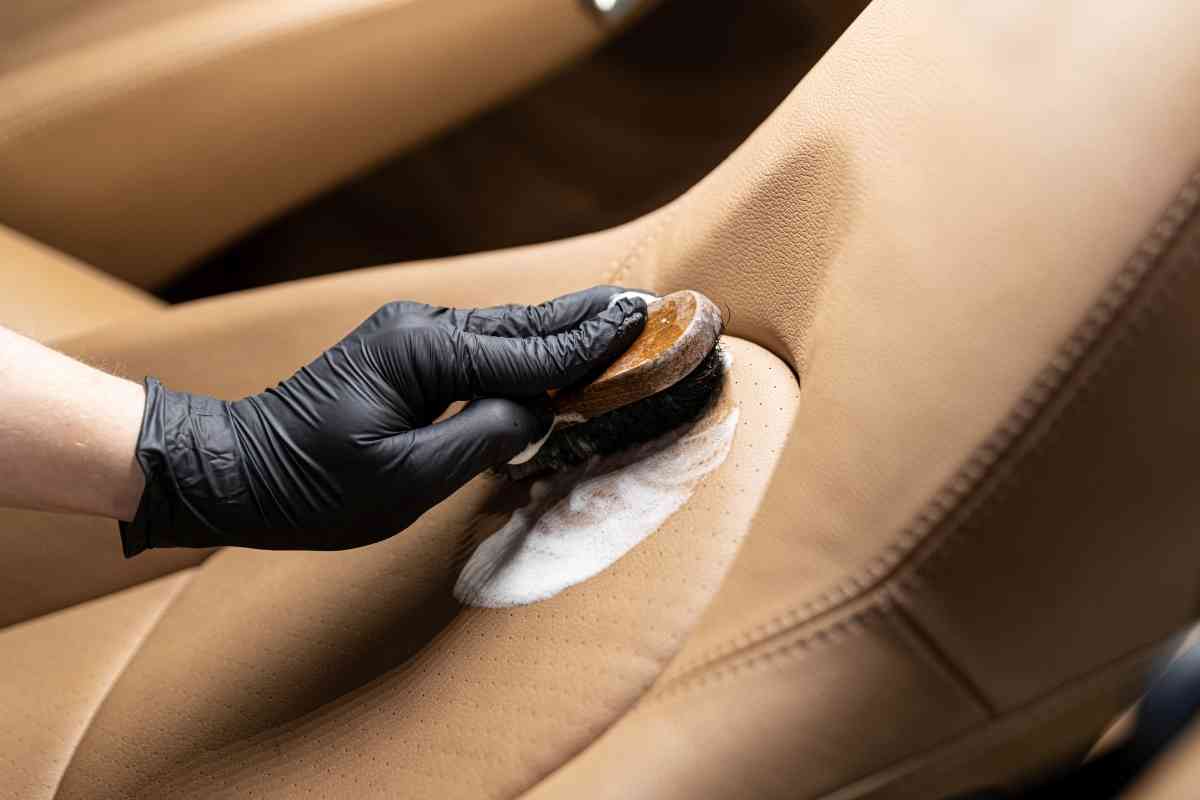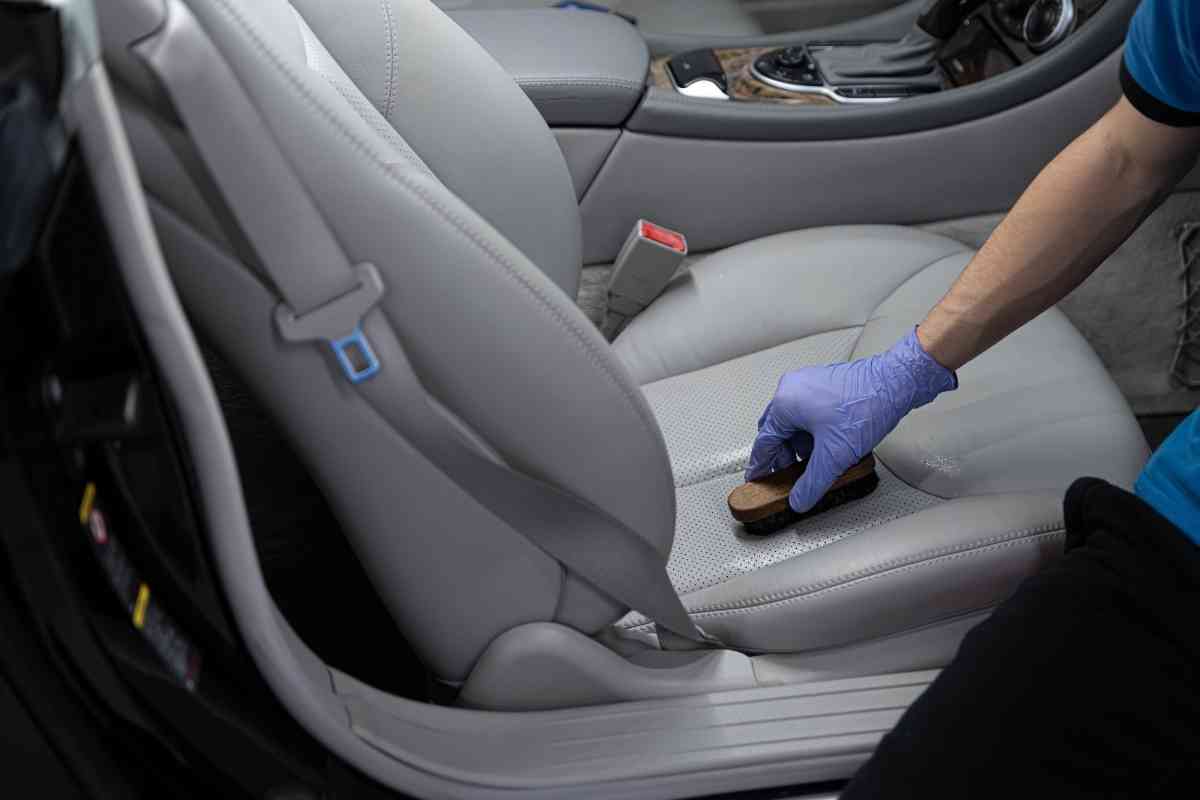6 Household Products You Can Use To Clean Leather Car Seats
Leather car seats, add a touch of luxury to your car, and regular maintenance with household products go a long way to ensure their lifespan. When we think of luxury cars, gleaming dashboards, polished paint jobs, and leather seats often come to mind. Of course, leather seats have been a staple in automobiles for over a century, covering dashboards, consoles, and car seats. While there are many professional products on the market to help clean and maintain the details of your car, plenty of household products will get the job done efficiently.

How do you clean leather seats with products around the house?
To help clean and maintain leather car seats, here are the top six household products:
- Castile Soap
- Rubbing Alcohol
- Non-Gel Toothpaste
- Lemon Juice and Cream of Tartar
- White Vinegar and Olive or Linseed Oil
- Baking Soda
As long as cars have been around, so have car owners looking to detail their cars without breaking the bank. Household products are perfect for both the interior and exterior of your car because they don’t contain the chemicals that can cause damage if misused, they are cheap, and they are usually found on hand for a last-minute maintenance task.
Below we break down these household items and how to use them. We’ll also add in some tips to maintain car seat leather and prevent future damage.
These household products have been a staple of car detailing for years, from the weekend warrior to professional detailers who have tested and reported back solid results.
Using Household Products to Clean Leather Car Seats
Preparation For Cleaning Leather Car Seats
Before attempting to treat localized stains or do a full round of maintenance on leather car seats, a few preparations should be undertaken.
Start by vacuuming in and around the seats to remove large debris. You can also use a high-powered blower for tight spots to blow out debris.
Go over the leather with a damp cloth to start with a clear canvas. If holes or rips exist in your leather, protect these areas with tape to block moisture or household cleaning remedies from soaking into the inner cushion.
Castile Soap
Castille soap is a gentle detergent made from vegetable-based oils such as hemp, coconut, or jojoba. It is known to be both gentle and strong and is made from saponified oils that have hydrating properties.
A well-known and easy to find castile soap is Dr. Bronner’s.
To remove a localized stain using a “blotting method”, castile soap and water are also perfect to remove spot stains from your leather car seats. To do this you’ll need two microfiber towels, castile soap, and warm water.
- Prepare a mixture of five parts warm water to one part castile soap.
- Start by blotting the liquid stain with a dry cloth to remove excess moisture.
- Dampen a microfiber cloth with the castile soap mixture.
- Gently wipe over the entire area of the car seat.
- Dry with a clean microfiber cloth.
Rubbing Alcohol
Rubbing alcohol, or nail polish remover, are great for treating trouble spots like pen marks on car leather seats. To do this, you’ll need rubbing alcohol (or nail polish remover) and a cotton ball.
- Apply alcohol to cotton swabs.
- Dab the affected area until the ink begins to loosen.
- Take care not to rub the ink, but use precise blotting movements until ink marks are gone.
Non-Gel Toothpaste

Toothpaste is a versatile household product that serves many purposes in car maintenance, and leather seats are no exception. This bathroom staple is a great tool for removing stains on leather car seats.
To use toothpaste to release local leather scuffs or stains, you’ll also need a soft toothbrush, damp sponge, and microfiber cloth.
- Use a dab of non-gel type toothpaste on a clean microfiber cloth over the stained area of the leather.
- Use a toothbrush to scrub the area lightly until the stain releases.
- Wipe the area with a damp sponge.
- Dry with a clean microfiber cloth.
Lemon Juice and Cream of Tartar
This mixture of lemon juice and cream of tartar uses a high citric acid content, low pH, and antimicrobial properties to clean car seats effectively.
Cream of tartar is the byproduct of fermentation in wine products. The chalky, powdery substance left behind is usually used in baking but also has great cleaning properties due to its mildly abrasive and acidic properties.
To use lemon juice and cream of tartar to clean leather car seats, you will need these two ingredients as well as a moist sponge, small spray bottle, and dry microfiber cloth.
- Mix equal parts lemon juice and cream of tartar and add to a spray bottle.
- Spray evenly across the leather surface.
- Let sit for up to 30 minutes.
- Use a moist sponge to wipe up the remaining mixture.
- Buff dry with a microfiber cloth.
White Vinegar and Olive or Linseed Oil
Oil and vinegar not only make a great salad dressing, but they also have natural compounds that make them a great household product for refurbishing leather car seats. Vinegar is a great solvent, disinfectant, and deodorizer. Oil is a great all-around leather conditioner that can also break down pesky stains in leather.
Linseed oil, in particular, acts as a sealant after the initial cleaning, preventing mildew growth and future damage.
To use this method, you will need white vinegar, oil (linseed or olive), a spray bottle, and a microfiber cloth.
- Mix a quarter cup of oil with a half cup of white vinegar and add to a spray bottle. Shake thoroughly.
- Spray mixture evenly across leather car seats and wipe with a clean microfiber cloth.
- Let the mixture sit for around 30 minutes before doing a final wipe-down of the surface.
Baking Soda
Baking soda is a great household cleaning agent to remove sticky and greasy stains from your leather car seats from errant food particles and spills. It has abrasive, adsorbent, and smell-fighting properties that make it an all-around easy do-it-yourself cleaning product.
To do this, you’ll need two microfiber cloths, baking soda, and some water. You can follow these easy steps:
- Sprinkle baking soda on the affected area.
- Dampen a microfiber cloth and buff the area with small circular motions.
- Let the baking soda sit for an hour or up to a day.
- Wipe off the mixture with a clean cloth.
- Wipe residue with a damp cloth and again with a dry microfiber cloth.
Tips For Cleaning Leather Car Seats
In general, household products, when used correctly, are mild and easy to use. However, there are a few things to remember when using any remedy, commercial or household, for the first time.
- Before using one of the above remedies, be sure to spot test in a small inconspicuous area, like the back of a seat, to ensure no unwanted color changes occur.
- Before rehabilitating leather seats, cover any torn or cracked areas to prevent cleaning products from getting inside the seat.
- Never apply a leather cleaning product, commercial or household, directly to the leather. Instead, dampen a microfiber cloth and work in small sections.
- Use only microfiber cloths for wiping and scrubbing. They are soft and won’t scratch sensitive leather surfaces.
- Try to clean your leather car seats at least once a month, even if there are no obvious stains. This will keep the necessity of hardcore maintenance down to a minimum. Less is more with leather car seats.
- Add a leather conditioner to your cleaning routine. Conditioners help to maintain and protect leather seats for an extended period by creating a sealant over the surface. This discourages the contact of grime and moisture.
Maintenance of Leather Car Seats
Regular maintenance of leather car seats is a must. Of all materials used to cover car seats – leather is the most prone to cracking from UV damage and lack of conditioning. In addition, over time, stains and bacteria collect on the surface of leather that can also cause irreversible damage if not addressed regularly.
Conditioning
To make the most out of the luxury of leather seats, be sure to maintain them at least four times a year and tackle stains and spills immediately. A good rule of thumb is that if the exterior needs to be cleaned, so does the interior. Committing to doing both at the same time will keep the overall maintenance of your car minimized.
Conditioning your leather seats regularly will go a long way to avoiding time-consuming fixes and maintenance. Prevention is the key to longevity for leather seats. Conditioners contain natural oils to restore the leather. Be sure to avoid conditioners with silicone or wax that can leave seats feeling greasy.
Finally, when using a conditioning product, spot test in a small inconspicuous area, taking care to not leave behind excess residue that will cause inconsistency in color. Go over a conditioning treatment with a final swipe using a microfiber cloth to ensure this build-up is removed.
